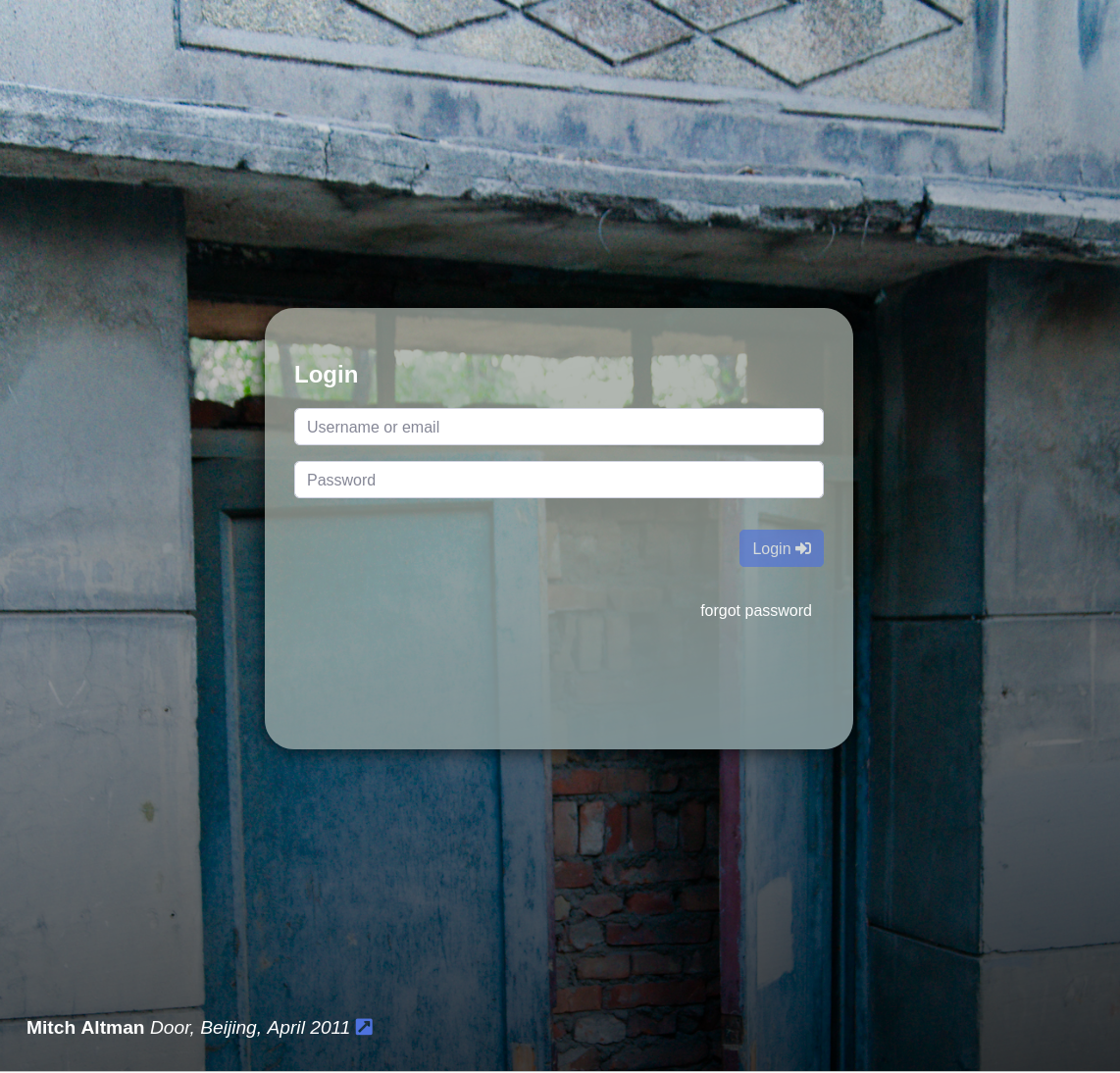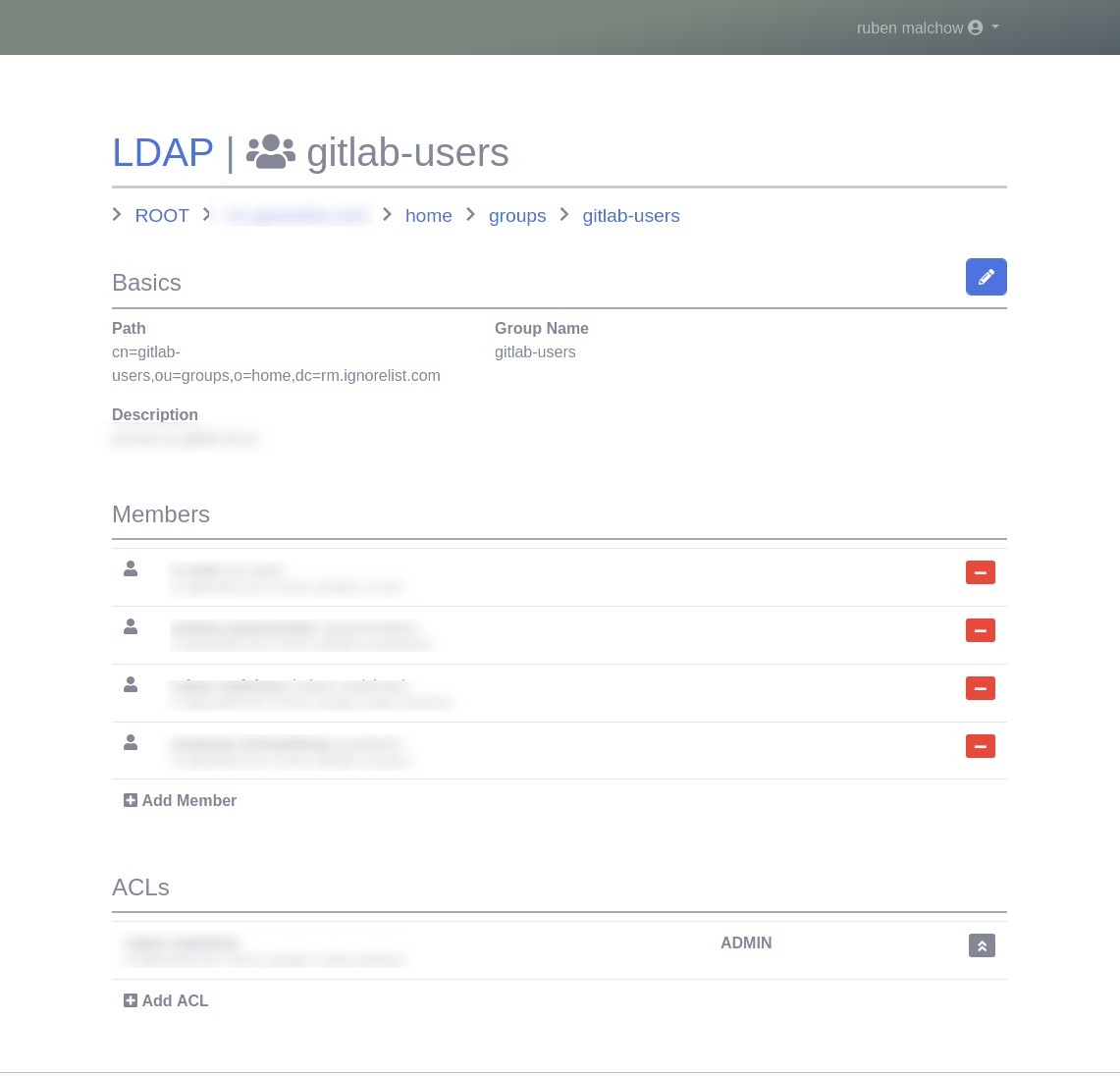this application is a small and simple UI to manage a basic LDAP setup. it currently works with an embedded Apache DS, and it can do basic user and group management tasks. it also allows you to delegate certain things (e.g. manage users of one group) without dealing with LDAP ACLs.
behind the scenes, all LDAP operations are executed in an administrative session, which has extensive privileges.
this application also ignores a lot of the finer points of LDAP, painting objects with rather coarse strokes. this may or may not be to your liking. For my personal usage, this is actually perfectly fine.
people who user this also user: my auth proxy - check it out here
this is not a full-on replacement for actual LDAP management tools (e.g. Apache Directory Studio). while basic things are nicer in here, we achieve this by simply ignoring most of the finer points of LDAP: we only do the bare essentials.
LDAP authentication is supported in a vast number of applications, and even mapping LDAP groups to local permissions is pretty popular. this is what this is for: scenarios where LDAP is not the central organziational platform, but rather a convenient single source of truth for authentication in other applications. if you insist on using LDAP trickery to implement your workflows, this is not for you.
so, this is for you if
- you want to manage media server, nextcloud and home automation access for you and your family at home
- you want to run build tools, a wiki and a git repository for the people in your local maker space.
- in short: if you have a collection of LDAP-capable tools running for a small-ish team, this might help you organize it.
i am planning to (eventually) include a bit more advanced functionality for editing LDAP objects, but this is never going to be THAT big (if you have urges, try FreeIPA or Keycloak or Privacy Idea).
this is meant to be run as a springboot application inside a docker container. it will need a separate mariaDB instance. the docker image is:
rmalchow/ldap:latest
this needs one volume mounted for the LDAP datafiles. It also needs a MariaDB configured.
An example docker compose file as well as a helm chart can be found here.
Env vars for use with docker compose
| key | value |
|---|---|
| URL | "https://users.example.com" |
| NAME | "Example LDAP" |
| MYSQL_HOST | "ldap-mysql" |
| MYSQL_PORT | 3306 |
| MYSQL_ROOT_PASSWORD | "mysql_root_pw" |
| MYSQL_DATABASE | "ldap" |
| MYSQL_USER | "ldap" |
| MYSQL_PASSWORD | "mysql_user_pw" |
| LDAP_ROOT_DN | "dc=ldap.example.com" |
| LDAP_ORG | "example-org" |
| LDAP_ADMIN_PW | "admin_pw" |
| MAIL_SENDER | "me@example.com" |
| MAIL_USER | "me-example.com@smtp.server" |
| MAIL_PASSWORD | "smtp_pw" |
| MAIL_HOST | "mail.example.com" |
| MAIL_PORT | 25 |
| MAIL_STARTTLS | true |
StartTLS vs TLS
if you want to use TLS on port 465 directly (not StartTLS), you will have to enable the included "SMTPS" profile using:
spring_profiles_active=smtps
this will change the socketfactory used:
spring.mail.properties.mail.smtp.socketFactory.port: 465
spring.mail.properties.mail.smtp.socketFactory.class: javax.net.ssl.SSLSocketFactory
Trust self-signed certificates
Don't, please.
Values for user with HELM
| value | description |
|---|---|
| ldap.hostname | hostname of the instance for use in http URLs, e.g. "ldap.example.com" |
| ldap.name | name of the instance, e.g. "Foobar User Management" |
| ldap.root | root of the LDAP tree, e.g. "dc=example,dc=com" |
| ldap.org | initial "organization" in the ldap tree, e.g. "foo" (will result in "o=foo,dc=example,dc=com") |
| ldap.admin_password | password of admin user |
| ldap.mail.enabled | en- or disable mailing |
| ldap.mail.host | SMTP host |
| ldap.mail.port | SMTP port (defaults to 25) |
| ldap.mail.sender | sender for the SMTP envelope |
| ldap.mail.username | username for authenticated SMTP (defaults to empty - no authentication) |
| ldap.mail.password | password for authenticated SMTP (defaults to empty - no authentication) |
- http listener on port 8080
- ldap listener on port 389
- persistent volume mounted to /app/data
| Name | Value | Description |
|---|---|---|
| URL | the public protocol and hostname for this instance, e.g. "https://users.example.com" | |
| NAME | the name of the instance | |
| LDAP_ADMIN_PW | password for the initial admin user | |
| MYSQL_USERNAME | "ldap" | the user to use on the DB. must have sufficient permissions to execute the flyway migrations (ALTER,DROP,CREATE etc) |
| MYSQL_PASSWORD | [NONE] | the password for the DB user |
| MYSQL_HOST | "mysql" | the hostname for the DB |
| MYSQL_PORT | "3306" | ... the port? |
| MYSQL_SCHEMA | "ldap" | the DB schema |
| SMTP CONFIG | ||
| MAIL_HOST | smtp server name | |
| MAIL_PORT | the port to use for outgoing SMTP. this can be STARTTLS. if you are planning to use straight-up TLS, you also have to set: "spring_profiles_active=smtps" | |
| MAIL_USER | username for the SMTP server | |
| MAIL_PASSWORD | password for the SMTP server | |
| MAIL_SENDER | email adress to use for SMTP envelope and reply-to headers |
- container port 3306
- one volume needed on /var/lib/mysql
This is a stock container. See their docs for details.
this application also has all functionality available as a REST API. for details on the APIs, see:
http://{your instance}/apitester/index.html
authentication is done by sending a POST request to the
/api/authenticate
API endpoint with a username, password and (optionally) a list of required groupIds. the return status:
- 200 if everything is OK
- 401 if authentication failed (e.g. incorrect username / password)
- 403 if the user is not authorized (i.e. not a member of the given groups)
- 500 if authentication failed due to an internal error
if everything is ok, the response body will contain a user object, and the server will send a cookie containing a JWT token for this user.
Attention - JWT authentication tokens issued by the server are very short-lived and must be renewed in regular intervals
a simple POST call to the authentication endpoint without parameters, but with a valid JWT token will return the authenticated user in the body, along with a freshly issued JWT cookie.
Every application does this slightly differently, but in general, the process goes something like this:
-
The user enters username and password
-
The application uses a "bind user" to connect to LDAP and find a matching LDAP object.
-
The application tries to bin with the DN (=distinguished name) and of that LDAP object with the password entered by the user
-
If this succeeds, the application retrieves some fields (i.e. email and display name) for further use
here's an example of my LDAP server configured in gitlab.rb
gitlab_rails['ldap_servers'] = YAML.load <<-'EOS'
main:
label: 'LDAP'
host: '192.168.21.220'
port: 389
uid: 'uid'
####### Here, we put the LDAP user & password
bind_dn: 'uid=admin,ou=system'
password: 's3cr3t'
############
# no support for TLS (yet)
encryption: 'plain'
verify_certificates: true
active_directory: false
allow_username_or_email_login: false
lowercase_usernames: false
block_auto_created_users: false
base: 'dc=my.base.dn'
####### this should be something that actually filters for a group
user_filter: 'memberOf=CN=gitlab-users,OU=groups,OU=home[...]'
############
attributes:
name: 'cn'
first_name: 'givenname'
last_name: 'sn'
sync_ssh_keys: false

